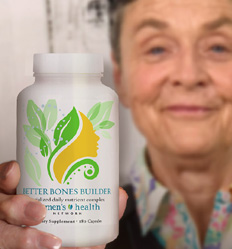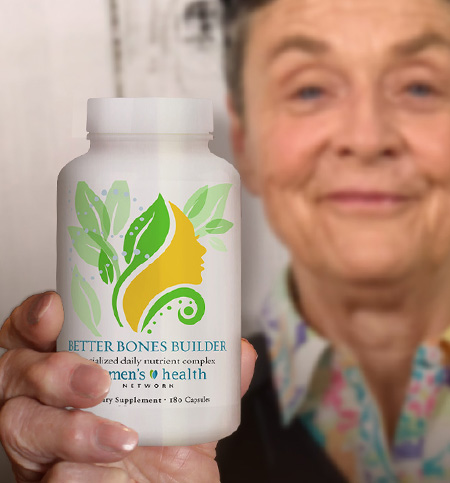Authored by Dr. Susan E. Brown
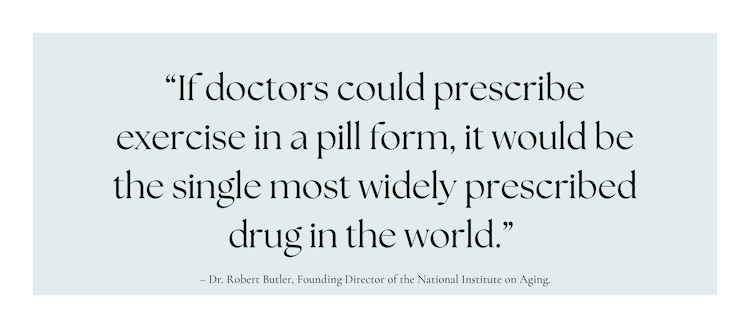
I love this powerful statement about exercise because it highlights that exercise isn’t just about keeping fit. It’s a cornerstone of a long, healthy life – and that includes strong and healthy bones that last a lifetime!
When it comes to fortifying your bones and ensuring they stay strong and resilient, exercise offers 5 remarkable benefits that make it an essential component of any bone health regimen.
Exercise — especially weight-bearing or resistance exercise — triggers new bone formation
As women, our bones naturally begin to lose density after our early 30s. Weight-bearing and resistance exercises can counteract this process by stimulating bone growth. Bones respond to the forces applied to them, including the force generated by muscles and tendons tugging on bones during movement, as well as the force of gravity. When you walk, run, hop and skip, you push against gravity to move. The physical stress of these movements sends signals to your bones to grow denser and stronger to help keep you moving.
Our bodies are constantly tearing bone down (resorption) and rebuilding it (remodeling), focusing efforts where they sense stress on the skeleton. For instance, athletes who are kayakers and rowers develop wider and stronger shoulder blades than runners. This is because the stress of constant paddling triggers extra bone-building in that area. Conversely, in our modern sedentary lives, there’s nearly zero stress on our skeletons, resulting in very little need for new bone formation.
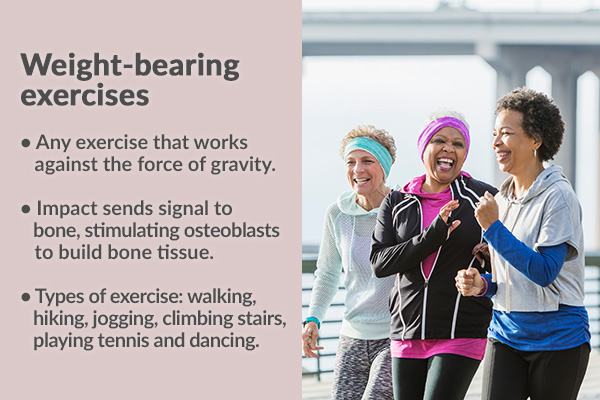
Think of simple exercises like brisk walking, hiking, jogging or even dancing as ways to tell your bones to “stay strong!” Incorporating activities like these into your routine at least three times a week can go a long way towards boosting your bone density, helping to fend off bone fragility and conditions like osteoporosis. For added bone-building impact, simply stand in place, jump and land firmly on both feet. You might also consider wearing a weighted vest during your next walk or workout. More weight pushing down (which your skeleton must resist) sends even stronger signals to your bones to start building.
Build muscle, build bone
Bone and muscle work together as a single unit, so any time you use a muscle, you’re stimulating your bones. This synergy is evident in research on strength-training exercises and their effects on bone density. For instance, a successful German study found that postmenopausal women gained an average of 11% bone mineral density in the hip after three years of strength training. Similarly, the LIFTMOR study showed that postmenopausal women who trained with heavy weights for just 30 minutes twice a week saw an average 3% increase in lumbar spine BMD. They also saw a 13.6% increase in cortical thickness in the hip over just 8 months, compared to a control group.
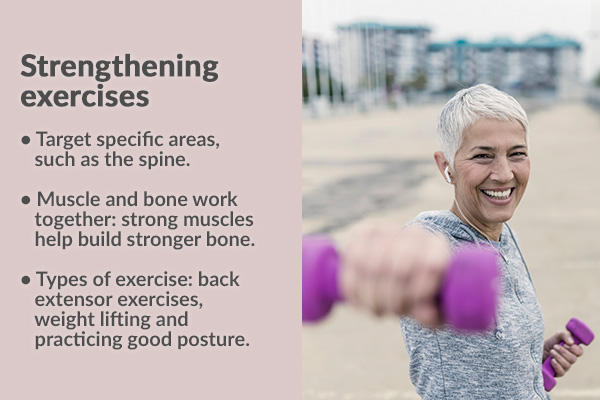
The beauty of strength training is that it is site-specific, meaning you can target particular muscles to strengthen particular bones. This is especially useful if you’ve been told you have bone loss in areas like your hip, spine or wrist.
Muscle strengthening benefits the rest of your body too! As you age, the benefits of building muscle and regular strength training include:
- Improved metabolism
- Enhanced mobility and balance
- Better bone health
- Enhanced cardiovascular health
- Better insulin sensitivity
- Increased independence
- Pain management
- Improved immune function
- Enhanced quality of life
To start accessing these benefits, incorporate simple strength-training exercises like squats, lunges, push-ups and resistance band exercises into your routine. Joining a strength training program at a gym or working with a personal trainer can provide you with more specific routines tailored to your needs.
Exercise alkalizes the body
Just like maintaining balanced blood sugar levels, the body must keep a stable pH to function properly. When acid/alkaline balance is off and the body senses a dip into acidity, it can “steal” alkalizing minerals from the skeleton as a mechanism to bring pH back into balance.
This response evolved as a short-term solution in an environment where we were easily and usually slightly alkaline. We didn’t need to borrow minerals from bone too often. If we did, our ancestral diets provided more than enough nutrition to replace these lost minerals. In modern life, however, the situation is completely different. Sugar, mental stress, caffeine and many other factors are acidifying. This puts many of us in a situation where our bodies are constantly tapping into our bone bank and not making many return deposits.
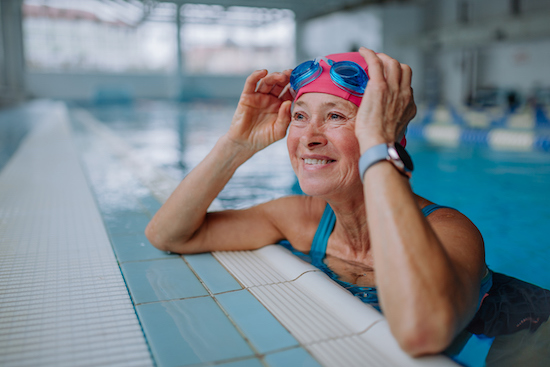
Exercise protects our bones from bone-weakening acidity because it helps stabilize pH balance. When you exercise, you increase your breathing rate and circulation. This alkalizes your body by removing more CO2 (carbon dioxide) than regular breathing. CO2 is acidic, so removing more of it and reducing its load has an alkalizing effect. This helps to restore pH balance and buffers your bones from the damaging effects of acidity.
Exercises that promote deep breathing and increased oxygen intake, such as aerobic exercises and yoga, can help alkalize your body. Pairing these exercises with a diet rich in fruits, vegetables and other alkaline-forming foods will further support your bone health by maintaining optimal pH levels.
Exercise balances hormones
For years, we’ve been told that women can lose up to one-fifth of their bone mass during the menopause transition and that estrogen is the crucial player. However, there is much more to the story. Fluctuating estrogen doesn’t make it impossible to build bone during perimenopause and menopause. Women’s bodies maintain bone best when our hormones are balanced, not just when they’re present at certain premenopausal levels.
Regular exercise helps to stabilize hormone levels, including estrogen, progesterone and testosterone. This not only helps preserve your bones but also comes with the nice side effect of reducing hot flashes, mood swings, irregular periods and other symptoms of menopause. Additionally, exercise, especially activities like yoga, walking and moderate aerobic exercises, can reduce cortisol levels. High cortisol, often triggered by chronic stress, is damaging to bone. And it can exacerbate perimenopausal symptoms leading to weight gain, fatigue, mood changes and accelerated bone loss. Keeping this hormone in balance is crucial for your overall well-being.
Low impact exercise improves coordination and balance (with big bone-building bonuses!)
For women, especially as we age, maintaining good balance and coordination is crucial to preventing falls and the fractures that can accompany them. Exercises that focus on balance and coordination, such as yoga, Pilates and tai chi, enhance neuromuscular function and stability. By regularly practicing these exercises, you can improve your body’s ability to stay upright and steady, significantly reducing your risk of falls. This is particularly important for women who are at higher risk of osteoporosis and related fractures.
Your bones love exercise so much that the benefits of low-impact exercise like yoga don’t stop at giving balance a boost. The research is clear that yoga can also help to build and maintain bone strength. Inspired by the work of Loren Fishman, MD, who first showed that older women who did yoga classes gained bone density while those who didn’t lost bone, a more recent groundbreaking clinical trial found that postmenopausal women with osteoporosis gained bone density after only 6 months of regular yoga practice.
Why does yoga work so well for bone health? There are many reasons:
• Yoga directly strengthens the muscles of the core, back and around the hips. Whenever you strengthen muscle, you strengthen the bone attached to it.
• Yoga stretches the muscles and also the bones. Stretching and bending of bone stimulates the signal for new bone formation, while reducing bone breakdown.
• Even though it might not appear so, yoga is weight-bearing. For example, standing on one leg puts all the weight of the body on one single leg, strengthening foot, leg and hip muscles.
• Yoga increases circulation, bringing nutrient-rich blood and oxygen to all tissues of the body.
• The focus on deep gentle breathing in yoga helps alkalize the body and rids bone-eating acids from the body.
• Yoga is a “mindful” exercise which helps balance the neuro-endocrine system, reducing bone-depleting cortisol and supporting hormonal balance.
• Two-thirds of women doing yoga reported positive postural changes in some research. Several studies suggest improvement even in established kyphosis.
Most exciting to me, when yoga involves even a short period of meditation you can expect altered gene expression within the body. With meditation, health-promoting beneficial genes are “turned-on” while clusters of “bad genes” that lead to disease are turned off.
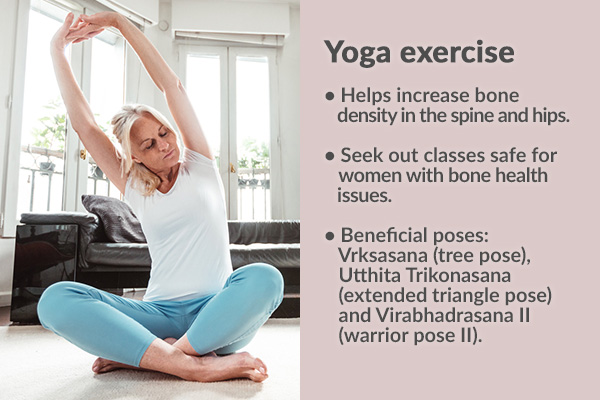
Get started with exercise for bone health!
If you decide to take up yoga for its bone benefits, you’ll see the best results with a practice of at least 4 times a week. Some postures used in yoga involve forward bends. These are generally not appropriate for those with spinal fractures or severe vertebral body weakness. Depending on your back strength, you may need to work on some adaptations to these postures with your yoga instructor.
Consider training with a knowledgeable yoga teacher. They can help you determine the most appropriate poses for you to reap the many bone benefits of this easy and fun form of exercise.
Exercise offers a wealth of benefits for women’s bone health, from building stronger bones and muscles to improving balance and hormonal health. Best of all, it’s never too late to start! There are so many simple ways to make exercise your ally in achieving and maintaining strong, healthy bones. See our article, “Best exercises for bone strength — how exercise helps prevent osteoporosis” for ideas to get moving.







